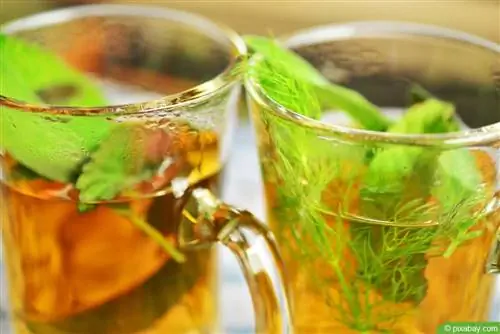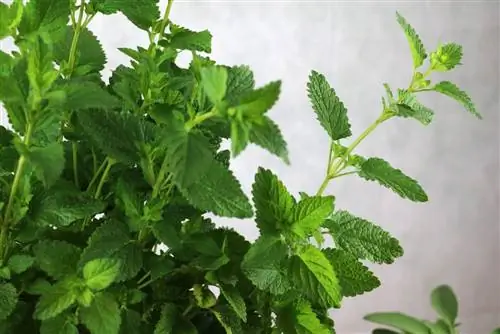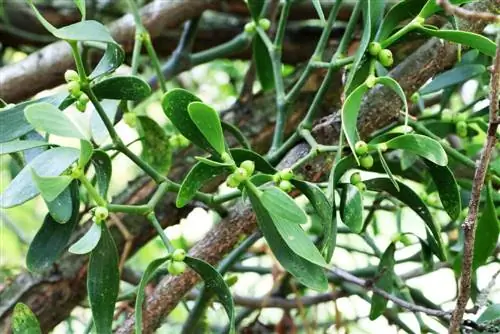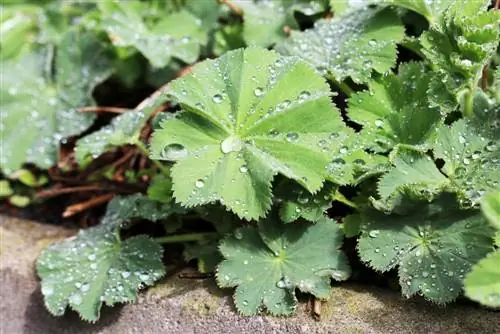- Author admin [email protected].
- Public 2023-12-17 03:39.
- Last modified 2025-01-24 12:45.
Perennials and trees often have a hard time bearing the weight of flowers or fruits. Without appropriate supports, they would bend or even break off, which would harm the entire plant. There are numerous ways in which plants can be protected during growth and maturation. You don't always have to buy expensive plant supports, because you can make practical supports yourself from simple materials.
Plant Support Materials
The more magnificent perennials are, the greater the risk that their branches will no longer be able to withstand the load. Heavy rain or strong winds in autumn or even a summer thunderstorm, possibly with hail, can cause considerable damage to the plants, which in the worst case can mean that the perennial needs several seasons to recover or even dies completely. Many materials can be used as supports, and they often even fall off in the house. The most popular materials include:
- Wood
- Plastic
- Metal
Wood in particular can be used as a support, but has a significantly shorter shelf life compared to other materials. The advantage is that half-rotted wood can easily be disposed of in the compost heap. Plastic supports are particularly suitable for annual perennials as they should not be left outdoors over the winter. The plastic becomes brittle due to the cold temperatures and can often break after the first winter. Metal supports are significantly ahead of other materials in terms of robustness and longevity, but are often a bit expensive. However, inexpensive plant supports are often used in the home or during renovation work. Old boards can be sawn to create thin rods as supports. Old plastic and metal pipes can also be reused as supports for plants. The positive side effect of recycling is that the amount of waste that has to be disposed of is significantly reduced.
Plant partnerships as support
An important support for plants can be the right plant neighbor. With proper planning, perennial beds can get by with just a few supports. Compact and dense ornamental grasses protect against strong winds, for example:
- Delicate plants can lean on perennials with strong growth.
- When planting a perennial bed, attention should be paid to the different needs of the plants.
- Delicate perennials should be planted between plants with sturdy branches that can protect them.
- In addition, trees are particularly suitable as climbing and growth aids.
- Perennials automatically find their way in these natural growth aids and are therefore very well protected.
- Garden fences can also be used as plant supports. They are stable and give even larger perennials good support.
Natural materials for a natural garden
Only natural plant supports should be used in a natural garden. These include, for example, sticks made of wood, twigs or bamboo. When pruning trees, trees or hedges, suitable sticks can be set aside. These don't necessarily have to be straight. Overgrown branches in particular provide additional charm in a natural garden. Branches of hazelnut trees are also ideal as plant supports, as one- to two-year-old branches usually have a very straight growth. Hazelnut trees are often found on forest edges and fresh branches can often be found near the ground. Before twigs and branches of bushes or trees are used, they should be debarked and dried at least in the lower area. Otherwise, especially with bushes, it can happen that fresh branches begin to take root in the ground. As an alternative to self-cut branches, bamboo sticks can be used. Specialist retailers have a wide range of different lengths and thicknesses from which supports can be built.
Staves, trellises etc. as plant supports
The classic form of plant support is one or more rods. The perennial is also secured with a wide and soft band, such as a band made from old fabric scraps or nylon stockings. Ideally, three rods are used for support. They are arranged in a triangle around the plant and the rods are connected with a ribbon. The plant can then lean on the support, but also has enough space to grow. A trellis should be provided for climbing plants such as roses or climbing plants. To do this, a grid is made from rods, whereby the individual rods are simply attached to each other with a string. When building the grid, it should be planned large enough or have the option to expand. Remains of construction grids often fall off during construction work. These can also be used as a practical climbing aid, but should be fixed to two stakes, for example. Wicker braids are increasingly being used as plant supports. If there is already a willow in the garden, the branches that are left over during the annual pruning are usually ideal. They can be processed fresh, but should be dry before they are fixed in the ground so that the branches cannot form roots.
Support plants properly
The work is usually not done by building trellises. Proper fixation of the plants is also important. With trellises, the branches can be guided between the rods. Thicker branches can also be tied up. When tying to plant supports, it is important that the individual branches still have enough space to move. If they are tied flush, it can have exactly the opposite effect, with the branch bending at exactly this point. When tying up the plants, it is also important to pay attention to the direction of growth. If the plant is fixed in the opposite direction, problems can also arise and branches can bend despite support. With trellises, however, the direction of growth can be influenced, which shapes the entire perennial.
What you should know about plant supports soon
In order to avoid artificial support aids, you should think about where which plant will be planted when planning. In many cases there is no need to artificially support the plants because they support each other or are not exposed to the wind due to tall plants in the immediate vicinity.
- If you cannot do without artificial support aids, we recommend setting them up as early as possible!
- Don't wait for the plants to fall apart or bend.
- The canes should be about two-thirds the size of the adult plant
- and inserted into the soil near the base of the stem.
- It looks more natural and beautiful if you use supports made from natural materials: brushwood or bamboo sticks.
Examples of plant supports
- Multi-shoot clumps, such as peony, are best supported on wooden posts.
- Using a strong string prevents the shoots from falling apart and the flower heads from hanging downwards.
- A bamboo stick can support the stems of ornamental onions, the stems of various tall trees or individual delphinium panicles.
- You should make sure to stick the bamboo stick into the soil as close as possible to the plant and attach it to the stick more often!
- The diameter of the bamboo stick should not exceed that of the plant's trunk.
- To attach climbing plants to the support, you should use material that cannot cut into them. Tip: sisal cords (parcel cord).
But fruit trees also need support under certain circumstances when their twigs and branches are full of fruit and their own load can no longer be supported. It is best to support the corresponding branches from below with supports. Care should be taken to ensure that the branches rest loosely on the support and that there is no risk of individual chafing marks forming.






